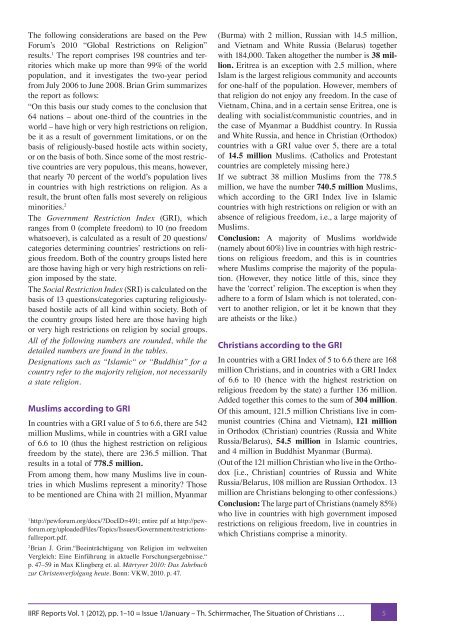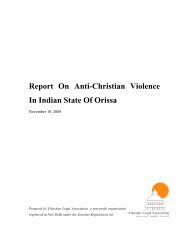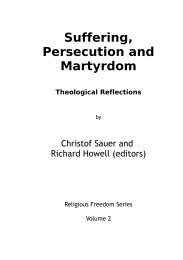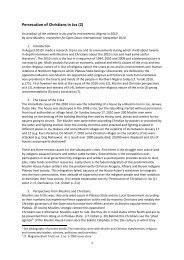download - International Institute for Religious Freedom
download - International Institute for Religious Freedom
download - International Institute for Religious Freedom
- No tags were found...
Create successful ePaper yourself
Turn your PDF publications into a flip-book with our unique Google optimized e-Paper software.
The following considerations are based on the PewForum’s 2010 “Global Restrictions on Religion”results. 1 The report comprises 198 countries and territorieswhich make up more than 99% of the worldpopulation, and it investigates the two-year periodfrom July 2006 to June 2008. Brian Grim summarizesthe report as follows:“On this basis our study comes to the conclusion that64 nations – about one-third of the countries in theworld – have high or very high restrictions on religion,be it as a result of government limitations, or on thebasis of religiously-based hostile acts within society,or on the basis of both. Since some of the most restrictivecountries are very populous, this means, however,that nearly 70 percent of the world’s population livesin countries with high restrictions on religion. As aresult, the brunt often falls most severely on religiousminorities. 2The Government Restriction Index (GRI), whichranges from 0 (complete freedom) to 10 (no freedomwhatsoever), is calculated as a result of 20 questions/categories determining countries’ restrictions on religiousfreedom. Both of the country groups listed hereare those having high or very high restrictions on religionimposed by the state.The Social Restriction Index (SRI) is calculated on thebasis of 13 questions/categories capturing religiouslybasedhostile acts of all kind within society. Both ofthe country groups listed here are those having highor very high restrictions on religion by social groups.All of the following numbers are rounded, while thedetailed numbers are found in the tables.Designations such as “Islamic“ or “Buddhist” <strong>for</strong> acountry refer to the majority religion, not necessarilya state religion.Muslims according to GRIIn countries with a GRI value of 5 to 6.6, there are 542million Muslims, while in countries with a GRI valueof 6.6 to 10 (thus the highest restriction on religiousfreedom by the state), there are 236.5 million. Thatresults in a total of 778.5 million.From among them, how many Muslims live in countriesin which Muslims represent a minority? Thoseto be mentioned are China with 21 million, Myanmar1http://pew<strong>for</strong>um.org/docs/?DocID=491; entire pdf at http://pew<strong>for</strong>um.org/uploadedFiles/Topics/Issues/Government/restrictionsfullreport.pdf.2Brian J. Grim.“Beeinträchtigung von Religion im weltweitenVergleich: Eine Einführung in aktuelle Forschungsergebnisse.“p. 47–59 in Max Klingberg et. al. Märtyrer 2010: Das Jahrbuchzur Christenverfolgung heute. Bonn: VKW, 2010. p. 47.(Burma) with 2 million, Russian with 14.5 million,and Vietnam and White Russia (Belarus) togetherwith 184,000. Taken altogether the number is 38 million.Eritrea is an exception with 2.5 million, whereIslam is the largest religious community and accounts<strong>for</strong> one-half of the population. However, members ofthat religion do not enjoy any freedom. In the case ofVietnam, China, and in a certain sense Eritrea, one isdealing with socialist/communistic countries, and inthe case of Myanmar a Buddhist country. In Russiaand White Russia, and hence in Christian (Orthodox)countries with a GRI value over 5, there are a totalof 14.5 million Muslims. (Catholics and Protestantcountries are completely missing here.)If we subtract 38 million Muslims from the 778.5million, we have the number 740.5 million Muslims,which according to the GRI Index live in Islamiccountries with high restrictions on religion or with anabsence of religious freedom, i.e., a large majority ofMuslims.Conclusion: A majority of Muslims worldwide(namely about 60%) live in countries with high restrictionson religious freedom, and this is in countrieswhere Muslims comprise the majority of the population.(However, they notice little of this, since theyhave the ‘correct’ religion. The exception is when theyadhere to a <strong>for</strong>m of Islam which is not tolerated, convertto another religion, or let it be known that theyare atheists or the like.)Christians according to the GRIIn countries with a GRI Index of 5 to 6.6 there are 168million Christians, and in countries with a GRI Indexof 6.6 to 10 (hence with the highest restriction onreligious freedom by the state) a further 136 million.Added together this comes to the sum of 304 million.Of this amount, 121.5 million Christians live in communistcountries (China and Vietnam), 121 millionin Orthodox (Christian) countries (Russia and WhiteRussia/Belarus), 54.5 million in Islamic countries,and 4 million in Buddhist Myanmar (Burma).(Out of the 121 million Christian who live in the Orthodox[i.e., Christian] countries of Russia and WhiteRussia/Belarus, 108 million are Russian Orthodox. 13million are Christians belonging to other confessions.)Conclusion: The large part of Christians (namely 85%)who live in countries with high government imposedrestrictions on religious freedom, live in countries inwhich Christians comprise a minority.IIRF Reports Vol. 1 (2012), pp. 1–10 = Issue 1/January – Th. Schirrmacher, The Situation of Christians … 5







